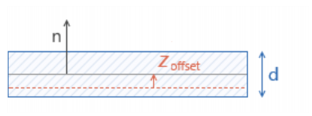|
•
|
For Physical offset enter a value or expression in the zoffset field for the actual distance from the meshed boundary to the shell midsurface.
 |
|
•
|
For No offset it means that the modeled boundary coincides with the shell midsurface.
|
|
•
|
For Physical offset enter a value or expression in the zoffset field for the actual distance from the meshed boundary to the shell midsurface.
 |
|
•
|
For Relative offset enter a value or expression in the zrel_offset field for the offset as the ratio between the offset distance and half the shell thickness. A value of +1 means that the actual shell bottom surface is located on the meshed boundary, and a value of -1 means that the shell top surface is located on the meshed boundary.]
 |